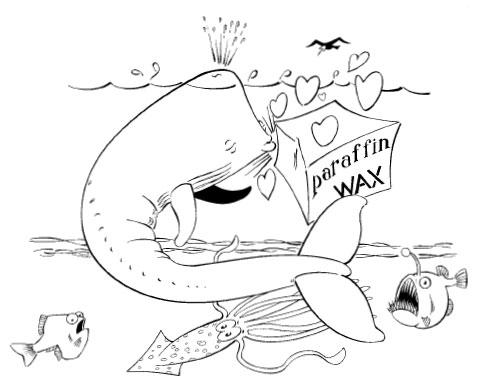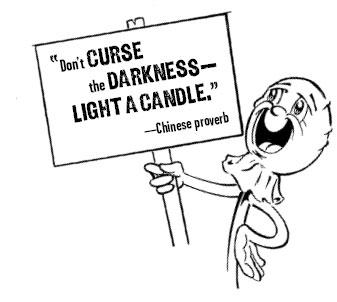When All Hell Breaks Loose (68 page)
Read When All Hell Breaks Loose Online
Authors: Cody Lundin

Not much is known about the origin of candles. Some scholars think they were first developed by the Egyptians, who used torches called "rush lights." They were made by soaking the pithy core of reeds in melted tallow or animal fat, although they had no true wick like a candle. The Romans win the prize for developing the wick candle, and they used it for everything from lighting homes and traveling at night to illuminating churches for worship. Similar to the Egyptians, they used tallow, the rendered fat from cattle or sheep, as the fuel element. Two-thirds of the tallow came from the solid fats palmitin and stearin with one-third from the liquid fat olein. Candles made from tallow smoked like crazy and emitted a certain odor that wouldn't go over well on a first date. In the Middle Ages someone finally discovered the wonders of beeswax and its delightful, clean-burning flame, although it was expensive at the time.
In the late eighteenth century, the whaling industry boomed partly due to the discovery of a wax called
spermaceti
that was obtained by crystallizing sperm whale oil. Fortunes were made and by 1792 the whaling port of Nantucket alone had ten candle factories. This wonder fuel could be produced not only in quantity (one sperm whale could contain hundreds of gallons of the precious goo), thus making the price cheaper, but it also burned just as clean as beeswax, had a higher degree of candlepower than anything else, and was harder and didn't bend in the summer sun.
In 1850, much to the relief of a diminished whale population, a substance called paraffin wax was made from oil and coal shales. The greatest advantage of paraffin was its cost; it was the cheapest to produce of anything that had been tried as a candle fuel. This, along with the discovery of an additive called stearic acid, solved the problem of paraffin's low melting point. With the introduction of the light bulb in 1879, candle making declined until the turn of the century when a renewed popularity for candles emerged.
Technically speaking, a candle is defined as one or more combustible wicks supported by a material that constitutes a fuel that is solid, semisolid, or quasi-rigid at room temperature, 68 to 80 degrees F (20 to 26 degrees C). It can also contain additives, which are used for color, stability, odor, or to alter the burning characteristics, the combined function of which is to sustain a light-producing flame. A candle flame burns its fuel in distinct regions within the flame itself. The differences are reflected by the various colors appearing within the flame. The hotter-burning blue areas burn hydrogen that has been separated from the fuel to form water vapor. The brighter, yellow part of the flame is carbon soot being oxidized to form carbon dioxide. Thus, a well-made, properly burning candle produces mostly harmless water vapor and carbon dioxide. The chances of carbon monoxide poisoning with candles is almost nonexistent as you would need many, many candles in a very confined space.

CANDLE SAFETY TIPS—COURTESY OF THE NATIONAL CANDLE ASSOCIATION (NCA)
The nature of a candle is a direct flame burning within whatever environment it's used, thus their use is not without risk. According to the U.S. Fire Administration (USFA), irresponsible candle use is responsible for approximately 10,000 residential fires each year, along with 1,000 civilian injuries, 85 fatalities, and $120 million in property loss. National fire safety agencies in the United States report that the vast majority of mishaps with candles occur from stupid actions or negligence. To set the record straight and make sure that you're on the straight and narrow regarding your family's candle use, the National Candle Association recommends the following safety tips when burning candles. Many of these common-sense tips will apply to any radiant-flame lighting devices, such as lanterns and oil and fat lamps.
(
Warning!
Any fuel-burning lighting source poses a risk for fire danger. Have a quality fire extinguisher on hand at all times and make sure that it's rotated and replaced or serviced on a regular basis.)
Always keep a burning candle within sight. Extinguish all candles when leaving a room or before going to sleep.
Never burn a candle on or near anything that can catch fire. Keep burning candles away from furniture, drapes, bedding, carpets, books, paper, flammable decorations, etc.
Keep candles out of the reach of children and pets. Do not place lighted candles where they can be knocked over by children, pets, or anyone else.
Read and carefully follow all manufacturer instructions.
Trim candlewicks to one-fourth inch each time before burning. Long or crooked wicks cause uneven burning and dripping.
Always use a candleholder specifically designed for candle use. The holder should be heat resistant, sturdy, and large enough to contain any drips or melted wax. Be sure the candleholder is placed on a stable, heat-resistant surface.
Keep burning candles away from drafts, vents, and air currents. This will help prevent rapid, uneven burning, smoking, and excessive dripping. Drafts can also blow lightweight curtains or papers into the flame where they could catch fire. Ceiling fans can cause drafts.
Keep the wax pool free of wick trimmings, matches, and debris (aka dead moths and other unrecognizable flying insects) at all times.
Do not burn a candle for longer than the manufacturer recommends.
Always burn candles in a well-ventilated room.
Extinguish the flame if it comes too close to the holder or container. For a margin of safety, discontinue burning a candle when two inches of wax remain (one-half inch if in a container). This will also help prevent possible heat damage to the counter/surface and prevent glass containers from cracking or breaking.
Never touch or move a votive or container candle when the wax is liquid.
Extinguish pillar candles if the wax pool approaches the outer edge.